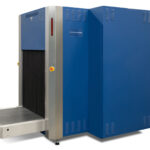Drones have been used in a 3D modelling trial at a UK nuclear site, paving the way for increased safety of employees during decommissioning.
The successful deployment of the Elios 3 drone equipped with a LiDAR sensor marks a major milestone for the unmanned aerial vehicle (UAV) team, enabling Sellafield Ltd “to achieve unparalleled efficiency in mapping and 3D modelling”, the company said.
The team successfully flew the Elios 3 drone with a RAD (Radiation Activity Detection) dosimeter, which they hope will allow them to map nuclear radiation hotspots.
Nuclear safety
Amanda Smith, UAV equipment programme lead, based at Sellafield Ltd’s Engineering Centre of Excellence in Cleator Moor, said: “We are thrilled that this first flight of Elios 3 with the LiDAR payload was a success and the data collected is now being processed in a Computer Aided Design system which will produce a 3D model of the area in question, helping to inform engineering decisions going forwards.
“Sending a drone into this tight and unused space rather than an employee in the first instance reduces risk, and also saves time and money.
“The team put a lot of work into making sure they were fully prepared for this flight. There are building plans they can study and try to work out the best route for the drone to take.
“However, these plans are decades old and, as in this case, the pilot encountered obstacles we weren’t expecting. The access into the area was also tighter than expected.
“He had to adapt to the changing circumstances incredibly quickly as he only had eight minutes of battery power to get into the area, map it with the equipment, and get out again. We always have two pilots on every flight as even though it is a short flight the levels of concentration required by the pilot are extremely high and at Sellafield we want to ensure the safety of our pilots and the equipment.”
‘Lot of pressure’
Sam Jay, UAV equipment engineer and chief pilot, said: “The flights can be very intense and in this case there was pipework everywhere. The drones fly in a cage with sensors so if they do happen to touch anything they won’t be damaged. The hardest part is remembering your way out again. In such a short space of time you need to get in and out quickly.
“There can be a lot of pressure as not getting the drone out and having to send someone in after it would defeat the point of the flight.
“Now that we have scanned the area the engineers can design scaffolding before they go to unblock a pipe which has been causing an issue in this particular area. By deploying the drone, and speeding up the process we have potentially saved the company, and the taxpayer, hundreds of thousands of pounds.”
Subscribe to the FINN weekly newsletter
You may also be interested in
Royal Mail and Skyports launch electric drone deliveries
Sellafield drone team to carry out UK technology first
Drone pioneers from West Cumbria at the forefront of future technology

